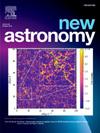High power accretion in massive binary systems and the impact of metallicity
IF 2.1
4区 物理与天体物理
Q2 ASTRONOMY & ASTROPHYSICS
引用次数: 0
Abstract
During a giant eruption of a very massive star in the binary system, the companion star can accrete a large amount of mass that can change its properties and potentially its subsequent evolution. The effect depends on the companion mass, metallicity, the amount of mass it accreted, orbital parameters and other parameters. We simulate individual companion stars assuming they undergo such accretion events. We study the envelope properties of 20 and 30 single massive stars at different metallicities (, and ) during accretion at different rates, from to . For the lower accretion rates we simulate, the stars remains hot, while at higher accretion rates, it becomes cooler and inflates. This behavior is observed in both stars but occurs at different accretion rates. Higher metallicity stars exhibit greater variations in accretion luminosity for the same accretion rate and stellar mass compared to lower metallicity stars. While higher metallicity stars typically have larger stellar envelopes, suggesting smaller variations in luminosity at Galactic metallicity compared to the LMC and SMC, our results show the opposite.
大质量双星系统的高功率吸积和金属丰度的影响
在双星系统中,一颗质量非常大的恒星爆发时,伴星可以吸积大量的质量,这可能会改变它的性质,并可能改变它随后的演化。这种效应取决于伴星的质量、金属丰度、它所吸积的质量、轨道参数和其他参数。我们模拟单个伴星,假设它们经历了这样的吸积事件。我们研究了不同金属丰度(Z=0.02, Z=0.008和Z=0.004)的20 M⊙和30 M⊙单质量恒星在不同吸积速率(从10−5到10−2M⊙yr−1)下的包层性质。对于我们模拟的较低吸积率,恒星保持热,而在较高的吸积率下,它变得更冷并膨胀。这种行为在两颗恒星中都可以观察到,但发生在不同的吸积速率下。与金属丰度较低的恒星相比,在相同的吸积速率和恒星质量下,金属丰度较高的恒星在吸积光度上表现出更大的变化。虽然金属丰度较高的恒星通常有更大的恒星包层,这表明与LMC和SMC相比,银河系金属丰度的光度变化较小,但我们的结果恰恰相反。
本文章由计算机程序翻译,如有差异,请以英文原文为准。
求助全文
约1分钟内获得全文
求助全文
来源期刊

New Astronomy
地学天文-天文与天体物理
CiteScore
4.00
自引率
10.00%
发文量
109
审稿时长
13.6 weeks
期刊介绍:
New Astronomy publishes articles in all fields of astronomy and astrophysics, with a particular focus on computational astronomy: mathematical and astronomy techniques and methodology, simulations, modelling and numerical results and computational techniques in instrumentation.
New Astronomy includes full length research articles and review articles. The journal covers solar, stellar, galactic and extragalactic astronomy and astrophysics. It reports on original research in all wavelength bands, ranging from radio to gamma-ray.
 求助内容:
求助内容: 应助结果提醒方式:
应助结果提醒方式:


